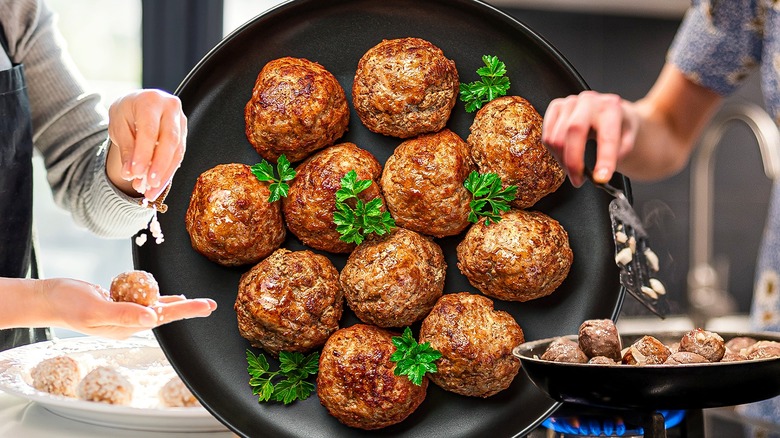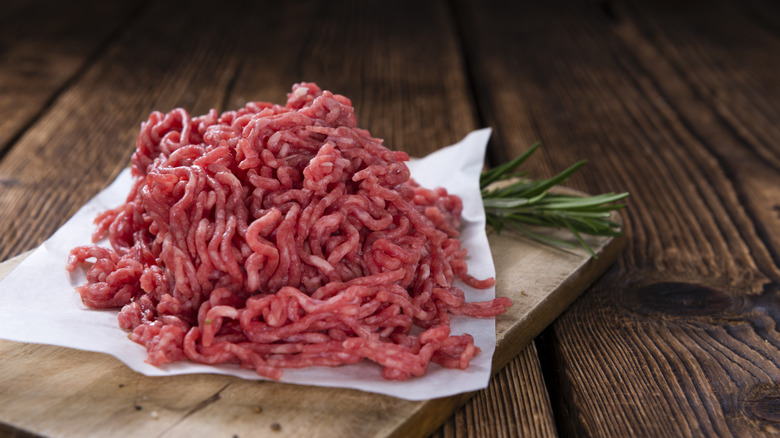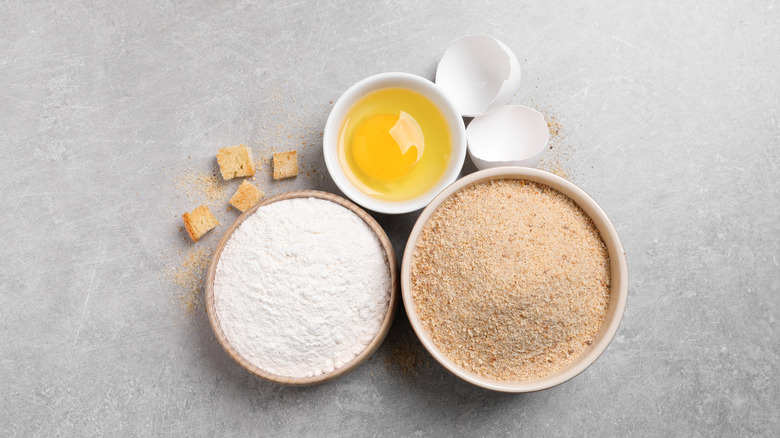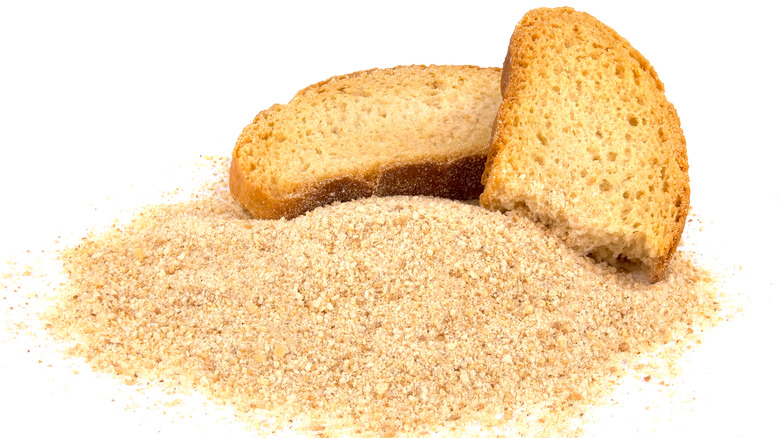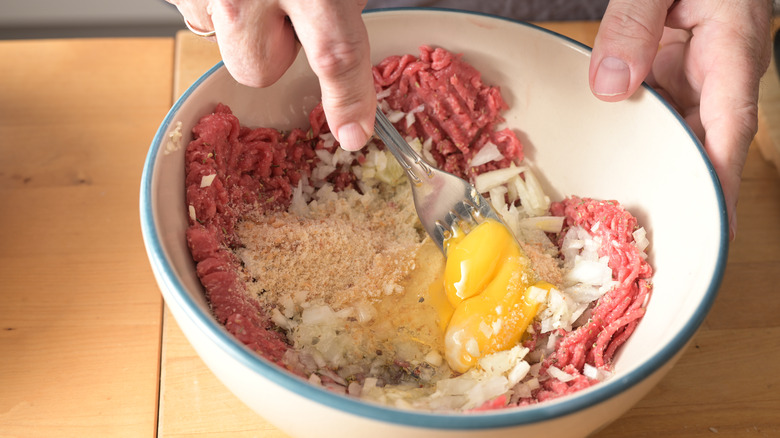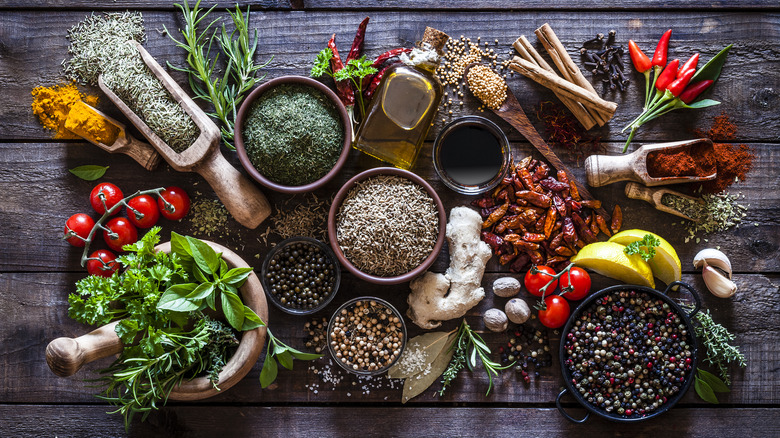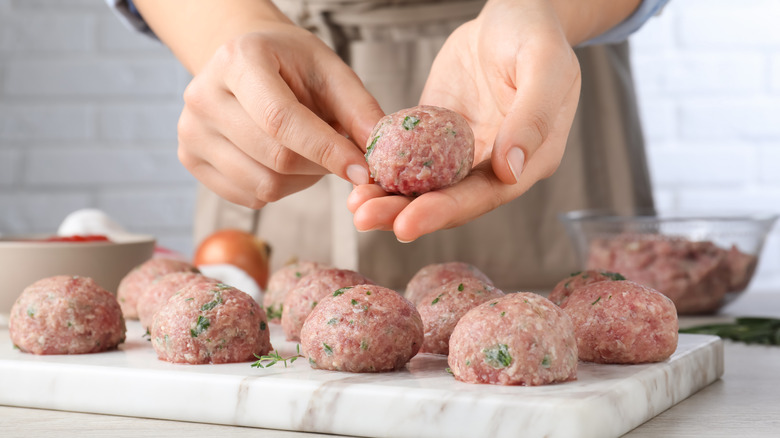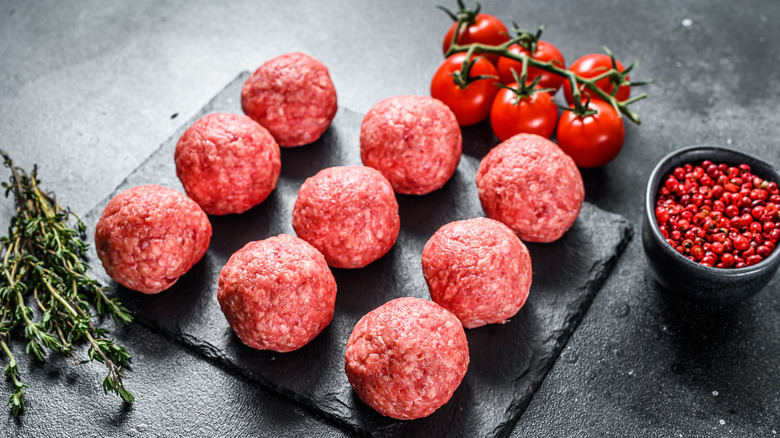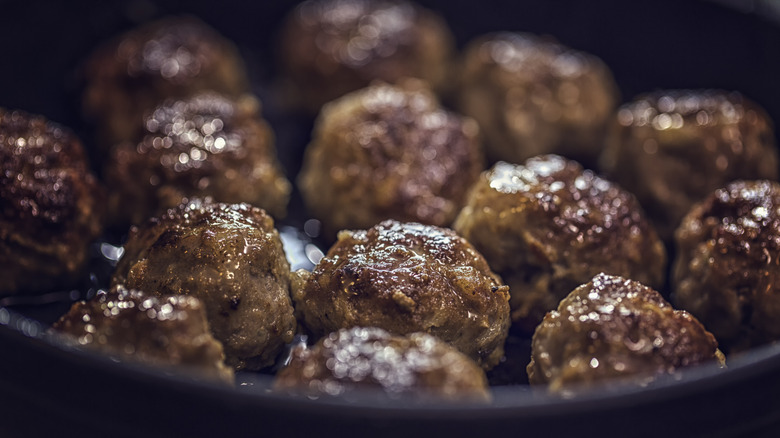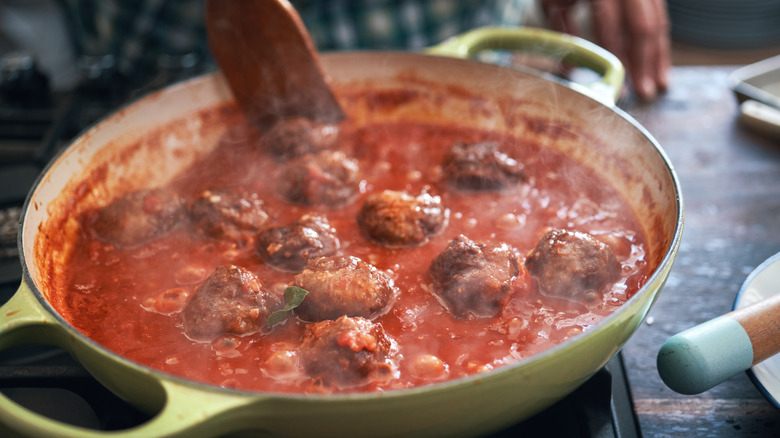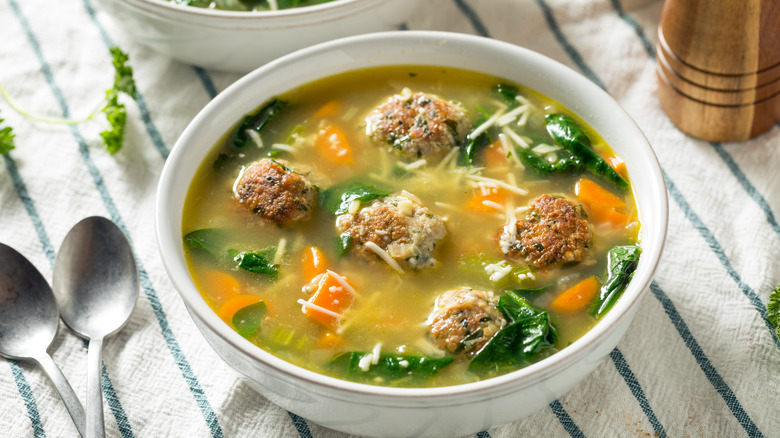11 Homemade Meatballs Hacks You Should Try
While it's all but impossible to know precisely when and where meatballs were created, we do know that for many years, across many different cultures, people found creative ways to make the most of the meat they had. Meatballs appear throughout the culinary world, from Latin America to Europe to the Middle East.
Every home chef should have a good meatball recipe. Whether that is the Italian-American favorite of spaghetti and meatballs, Swedish meatballs covered in creamy gravy, or spiced kofta balls served with hummus and flatbread, meatballs are a sure crowd-pleaser. They are also highly customizable, given that you can make them with practically any ground meat, from beef and pork to chicken and turkey. They can be gluten-free, keto, or dairy-free. You can even make them vegetarian or vegan with plant-based meats. Plus, they are a great place to hide vegetables for picky eaters. If you meal prep and batch cook, meatballs freeze well and can join many meals, like pasta, soup, sandwiches, or pizza. The possibilities are nearly endless.
If you are new to making meatballs, then be sure to check out these hacks. Perfecting this classic dish is a great way to impress your friends and family and enjoy some great food.
1. Start with the right meat
Making a truly good meatball starts with a trip to the butcher for freshly ground meat. The classic version uses a mix of beef and pork, with the beef used largely for its flavor and the pork for its fat. The secret to good meatballs is getting this meat-to-fat ratio just right. Cookbook author, restaurant owner, and meatball expert Daniel Holzman explained to First We Feast that the ideal ratio should be 70% meat to 30% fat. As long as that ratio stays intact, you can experiment with the types of meat you use. Less fatty meats like chicken and turkey can be mixed with pork or pork belly for instance. Here, the added fat helps keeps the meatball together and adds all-important flavor.
When it comes to meatballs, creativity is key. Home chefs can look to less-popular meats such as bison, venison, and elk for inspiration. If you are new to working with these proteins, ask your local butcher for tips on how to handle them properly. And if you want to grind your own meats at home, invest in a meat grinder. Either way, starting with quality meats is the first step to great meatballs.
2. Pick your binder
One of the classic problems when it comes to making meatballs is how to keep the ball from falling apart. That's where a binder is essential. The binder most commonly used today is a combination of eggs and breadcrumbs. The eggs provide moisture and help to form a gel, while the breadcrumbs are a filling agent that works to hold the whole shebang together.
While eggs and breadcrumbs are a classic combo in many a basic meatball recipe, they are not the only combination. Home chefs can use milk or oats for a similar effect, for instance. Throwing the oats in a blender first is a smart move, because this step helps to break them up, making the oats easier to work with. Blending oats also gives them a softer texture that is similar to breadcrumbs.
If you are making gluten-free or keto meatballs, ground pork rinds are an excellent choice that will also help the meatballs keep their shape. And for meatball lovers who can't eat eggs, chia seeds that have been ground and soaked in milk or water make an excellent egg substitute.
3. Make homemade breadcrumbs
If you use breadcrumbs as a meatball binder, here's an easy way to up your game: instead of buying packaged breadcrumbs, make your own. Homemade breadcrumbs are an excellent way to use up leftover stale bread. Any type of bread works in breadcrumbs, from whole wheat to rye to sourdough. As long as the bread is dry and crumbles, it will make good breadcrumbs. If you don't have stale bread, you can take a few extra minutes to dry the bread in an oven or air fryer. You can also just leave some on the counter and wait a few days. Just remember to add herbs and seasonings like oregano, basil, and thyme to the breadcrumbs, a move that will add to the overall flavor profile of your meatballs.
Some professional chefs skip the breadcrumbs altogether and instead opt for chunks of bread that they tear into small pieces and soak in milk. Added to the meat mixture, these pieces help to create a fluffy meatball. Try both versions and see which one you and your family like better.
4. Use a chilled bowl
One cool homemade meatball hack you should try is using a chilled bowl to mix your ingredients. This keeps the fat from getting soft and allows the meatballs to hold their shape before cooking. When fat is at room temperature and you use your warm human hands to mix it, your meatballs will likely get too soft and could even begin to fall apart. For best results, start with a chilled bowl, mix all of your ingredients, and then put the bowl back in the refrigerator. It only needs an hour or two there to make it easier to handle.
Another hack to help your meatballs keep their shape is to use two cold metal spoons to form the sphere. That way, the mixture doesn't get overworked with warm fingers. Just put two metal spoons in the refrigerator at the same time as the meat mixture. Be careful not to put them in the freezer, though, as the spoons will be too cold for you to touch.
5. Consider your seasonings
A common mistake home chefs make with meatballs is not seasoning them enough. When you are caught up in making sure the fat-to-meat ratio is perfect and that the binder will hold everything together, it's easy to forget that the taste is just as important as the texture.
The herbs you add to your meatballs will depend on how you plan to use them in the final dish. For Italian-style meatballs that you'll enjoy with pasta, pizza, or sub sandwiches, oregano, parsley, and basil are excellent seasoning choices. For Middle Eastern meatballs intended for a kofta, spices like cumin, coriander, and mint make the perfect blend. Other seasoning blends such as za'atar, Cajun, and Creole blends are great in meatballs as well. If you are using dried herbs rather than fresh, remember that the dried versions are stronger in flavor, so a little bit goes a long way.
Most meatball recipes call for garlic powder or garlic salt, but roasted garlic is also a good addition. Roasted garlic has a milder flavor, and its soft, buttery texture is easy to work into the meatball mix.
6. Get cheesy
Cheese in meatballs has two jobs. First, it can work as a binder to keep everything together and moist. Moreover, the right kind of cheese will add a lot of flavor. For classic Italian meatballs, use freshly grated Parmesano Reggiano. This aged hard cheese has a nutty flavor that will add something special to your meatballs. Other hard cheeses like Pecorino and Grana Padano are good options too. Make sure to grate the cheese on the finer side of your cheese grater so it mixes evenly with the rest of your ingredients.
Stuffing meatballs with gooey cheese is another fun hack that will amp up your meatballs. For stuffed meatballs, a soft cheese that melts well, like mozzarella, cheddar, or Provolone, is your best option. For a little extra kick of spice, flavored cheeses such as pepper jack, a habanero-infused cheddar, or a horseradish-infused white cheddar add a nice surprise when biting into a tender meatball. Frankly, as long as you can eat it, you can never go wrong with cheese.
7. Avoid overpacking your meatballs
When shaping meatballs, be careful not to overpack them. You want them to keep their shape, so they need to be packed together to a certain point, but exercise restraint. If you roll them too tightly or pack the mix into dense spheres, then the meatballs will likely become too chewy and may even end up with an unpleasant rubbery texture. So be gentle when packing them and find the balance between packing them too loosely or too tightly.
To avoid this, try oiling your hands before rolling the meat into balls. This helps keep your hands from sticking to the balls and makes it easier to avoid overworking the mix. Be sure to skip using flour on your hands, too. While it will keep your hands from sticking, it will add extra flour and flavorless filler to the meat mix. That said, some chefs recommend lightly dusting the meatballs with flour before you sear them.
8. Consider size
When you're shaping homemade meatballs, consider how you'll serve them. Small or mini meatballs work perfectly as appetizers at a party. Simply serve them with toothpicks and a dipping sauce for easy grazing at the buffet table. Medium size meatballs are good in pasta or soups. Meanwhile, large meatballs are great for hefty submarine sandwiches.
Adjust the cooking time depending on the size of your meatballs. A thermometer will help you ensure that the inside of the meatballs are fully cooked. According to the USDA, the minimum safe internal temperature for ground meat is 160 degrees Fahrenheit.
Several kitchen tools with aid you in making the perfectly-sized meatball. The most popular meatball maker resembles a melon baller or a small ice cream scoop and comes in different sizes so that you can make perfectly round meatballs for whatever meal you have in mind. Meatball shapers that look like a plastic egg carton are ideal for crafting stuffed meatballs. If you make meatballs often and don't like handling raw meat, a meatball maker might be a good addition to your kitchen gadgets.
9. Understand the Maillard reaction
When it comes to making delicious meatballs let science lead you and get to know the Maillard reaction. The Maillard reaction is the process of browning foods, here specifically how sugar and amino acids react under heat to create new color, flavor, and texture. Even if you didn't know the name of this chemical reaction, chances are you have seen it when toasting bread, searing steak, or baking cookies. This simple chemical reaction makes a big difference in meatballs, too.
Home chefs can achieve the Maillard reaction by browning their meatballs in a saute pan. Just add the meatballs to a shallow pan and don't overcrowd the pan so they have room to brown. Don't use a deep soup pot, as the meatballs might steam more than turn brown, defeating the purpose. Roasting meatballs in the oven or under the broiler is another way to kick off the Maillard reaction, so long as you turn them regularly to ensure that they brown evenly and create the perfect crust.
10. Finish meatballs in a sauce
To many, the best meatballs are braised. Braising the meatballs starts with first roasting or browning them to create a crust that holds the shape (they don't need to cook fully in the saute pan). Once the crust has formed, drop them in the sauce to finish cooking, so you get meatballs with texture on the outside and a moist, flavorful inside.
Another method of cooking meatballs is known as the drop method. Here, you skip the browning step and drop raw meatballs directly in the sauce to cook. While this method is a time-saver, it's not ideal for meatballs that need to uphold their structural integrity, such as one that will go into sandwiches or as appetizers for a party. However, the drop method is okay to use when the meatballs will be served in a sauce or soup, as the shape of the meatballs won't be quite as important.
11. Explore different styles of meatballs
In Mexico, a common meatball mixture includes dry rice. The resulting meatballs are often added to liquid, where they puff up as the rice cooks, making tasty Albondiga soup. In Germany, flat-bottomed meatballs called frikadellen can be pan-fried. Middle Eastern meatballs served kofta are typically filled with aromatic spices and grilled on skewers. Swedish meatballs, made famous for many Americans through IKEA, are smothered in a creamy, savory gravy. Japanese meatballs are served in a sweet and sour sauce. In Vietnam, meatballs known as bo vien can arrive in a hot bowl of pho topped with fresh hot peppers and bean sprouts.
If you love meatballs, then branch out a bit, take your cues from other cuisines, and make your homemade meatballs in different styles. You can also get creative and make your specialized meatballs with your favorite meat, binder, and spices. As long as it tastes good, there's no wrong way to make a meatball.
